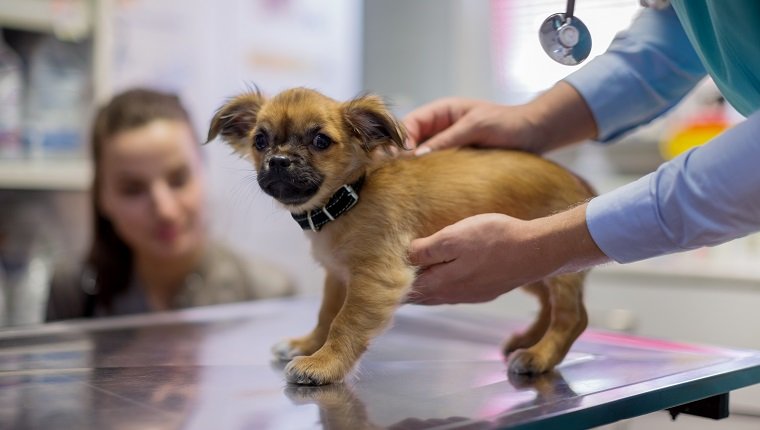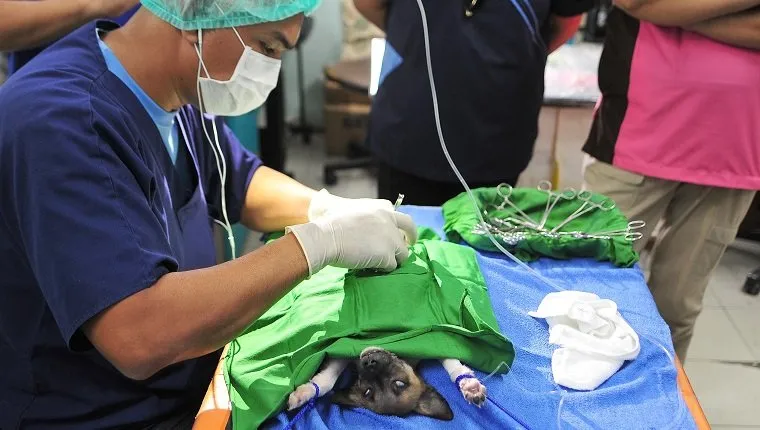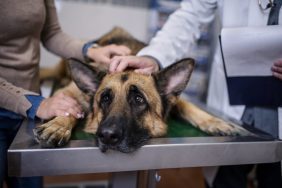
Cryptorchidism in dogs happens when one or both testicles are retained in the abdomen and fail to descend into the scrotum.
Usually the testes descend by the time a puppy is two months old. Though it may happen earlier or later in some breeds, it rarely happens after the age of six months. Generally, if one or both testicles haven’t descended by the age of four months, veterinarians suspect cryptorchidism.
The right testicle carries two times the risk of cryptorchidism as the left testicle. When only one testicle fails to descend, veterinarians refer to the condition as unilateral cryptorchidism. When both testicles remain un-descended, they call it bilateral cryptorchidism.
The un-descended testicles may either be retained in the inguinal canal, a passageway that connects the spermatic cord to the testes, or they may be retained elsewhere in the abdomen.
The condition can lead to serious complications in dogs, including testicular cancer, so it’s important to treat it quickly. If you suspect your dog suffers from cryptorchidism, contact your veterinarian right away. They can diagnose the condition and begin treatment as early as possible.
Here’s what you should know about the symptoms, causes, and treatments for cryptorchidism in dogs.
Symptoms Of Cryptorchidism In Dogs

There may be no direct symptoms of cryptorchidism in dogs, but there are several complications that might occur because of it. The main sign of this condition is that one or both testicles haven’t descended by around the age of four months.
If an un-descended testicle is retained in the inguinal canal, a veterinarian will likely be able to feel it by using abdominal palpitations. However, if it is elsewhere in the abdomen, the vet may need an ultrasound to determine its location.
One of the complications that may occur is spermatic cord torsion. This happens when the spermatic cord twists around itself, cutting off the blood supply to the testes. This will result in severe, acute abdominal pain.
Another common complication is testicular cancer. The risk of testicular cancer is ten times higher in dogs with cryptorchidism than dogs who don’t have it. Symptoms depend on the type of cancer.
Dogs with cryptorchidism may be infertile, as the testicles that haven’t descended generally fail to produce sperm. However, the testicles continue to produce testosterone.
There are a few developmental abnormalities that tend to occur alongside the condition. These include deformities in the legs, tail, eyes, and eyelids. Dogs may also suffer from hip dysplasia, luxating patellas (dislocated kneecaps), and a life-threatening heart defect called tetralogy of the Fallot.
Causes Of Cryptorchidism In Dogs

The exact cause of cryptorchidism in dogs is not known, though it is suspected that there is a genetic component.
While it can affect dogs of all breeds, it appears more commonly in toy breeds such as toy Poodles, Yorkshire Terriers, and Pomeranians. Vets suggest that pet parents neuter dogs who have the condition so they cannot pass it on.
Some suspect the issue isn’t genetic, but instead appears because of something that happens within the uterus during fetal development. It may be an environmental condition that only affects members of the same litter.
Whatever the case, the condition is currently not preventable.
Treatments For Cryptorchidism In Dogs

The treatment for cryptorchidism in dogs is neutering. It’s important to get this done both to prevent complications such as testicular cancer and to prevent the dog from potentially passing on the condition to offspring.
The procedure for neutering a dog with cryptorchidism is more complicated than it is with dogs who don’t have it. This is because it usually involves cutting open the abdomen and, in cases where the testicle cannot be found with an ultrasound, some medical exploration.
The veterinary surgeon should remove both testicles, even if only one fails to descend.
Researchers have attempted a few experimental treatments, including hormone injections in puppies and artificially descending the testicles. However, even artificially descended testicles retain the same high risk of testicular cancer.
These treatments are considered unethical, and when breeders have tried to continue a line in spite of a dog’s cryptorchidism, it usually results in pain for the affected dog. Neutering is generally safe and allows a dog to live a normal, healthy life in most cases.
Have you ever adopted a male puppy? Were you worried about conditions like cryptorchidism? Let us know in the comments below.









